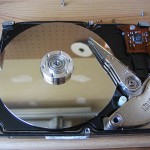External Hard Drives for computers have undergone a tremendous amount of evolution over the past 13 years. In the mid-late 1990’s, the hip thing was to use Zip Disks. These disks were very similar to 3 and 1/2 inch floppies, but they had around 80 times the storage space. The zip disks needed a special reader that plugged into the computer via parallel port. Before zip disks, people needed to have large boxes full of floppy disks. We would use WinZip to make backups of files that were larger than 1.44 megabytes. I remember having to “recurse subdirectories” in order for the backups to work correctly for folders with subfolders.
Zip Disks could sometimes hold up to 100 megabytes and so one of my custom built machines actually had a zip drive built in. Nowadays, some computers don’t even come with floppy ports.
As databases for business and space requirements for video and gaming grew, so did interest in hard drive technology. And as hard drives gained in capacity, so did their external counterparts.
The first large external hard drives for consumer use were bulky and expensive. They required their own power sources and were noisy and also generated a significant amount of heat. Since they were heavy, they were highly susceptible to damage from falling.
Before USB 2.0 came along. External Hard Drives used different connectors. Depending on the year they were made and their intended purpose, external hard drives used everything from parallel ports, custom proprietary ports, USB 1.1, or even FireWire.
FireWire was a huge breath of fresh air over USB 1.1 especially when massive amounts of data and throughput was required for video editing and other demanding tasks. USB 1.1 was great for connecting peripherals, but the hard drive storage capacity potential exceeded 1.1’s transfer rates during the early 2000’s. Although one could use 1.1 for transferring data, it was a migraine for power users. FireWire and USB 2.0 did a great job of coping with the new size of hard drives and the demands of users.
The advent of USB 2.0 made it so large external hard drives could be powered by the USB port of the laptop or desktop that they were connected to. This was a huge boon to professionals and consumers hobbyists alike, because it meant more portability, and the need for one less electrical socket at a meeting or in an apartment. But the external hard drive evolution didn’t stop there.
Around the same time in the middle of the 2000’s, two important things happened. The explosion of capacity for large external hard drives took place in he hundreds of gigabytes. Every six months, someone could look at the newspaper and try and find a large Fry’s advertisement on the back page. We would be astonished by the rapid rate of capacity for internal and external hard drives. This contrasted with he seemingly less impressive growth in CPU speed. CPU speed used to be the talked about number in he 86 years o the DX’s and the DX2 all the way up to the advent of Pentium and AMD cores. But eventually hard drive space, and especially portable hard drive space became the hot discussion.
The second major thing hat happened during he mid 2000’s was the miniaturization of external hard drives. For those needing large amounts of space, the drives became less bulky. Today, external hard drives continue on that trend and the last drive I purchased was a USB 3.0 external hard drive with a capacity of 500 gigabytes. The drive is a quarter of the physical size of one of my old Seagates and it is a third as heavy. Yet the hard drive evolution took a proverbial mutation detour, when hard drive technology learned a thing or two from Random Access Memory.
Random Access Memory or RAM as we all know it now, is quite different from conventional hard drives that used magnets to store and write data. RAM was designed to temporarily store program data so it can be executed by the computer and eventually displayed on the screen and made so users can interact with the programs. That is a very rough description of the process but a quick analogy could be to think of a Hard Drive as a human’s long term memory where important information is stored for long period of time. But the RAM is like our short term memory where we hold information about the cheese we need to purchase for today’s omelet and how much change we got back from the cashier. That information is only needed for each moment of the day.
Well, RAM and External Hard Drives had a strange love child which is what we call the new style Flash Drives. Flash Drives use chipsets that are slightly similar to RAM, but these Flash Drives have long term storage capacity like Hard Drives. These Flash Drives have grown in capacity and decreased in size so fast that we have seen drives become smaller than the USB interfaces that connect them to the computers. This type of technology makes it so someone can hold a 10 gigabyte flash drive in his or her pocket that has the capacity of more than 6,900 old-school floppy disks. Imagine bringing 6,900 three and-a-half inch floppy disks to a business meeting in order to demonstrate a video presentation. You would need an entire team of people to just get your presentation into the room, and then what happens if one disk got misplaced?
The evolution continues to grow and the camera and photography industry did an excellent job of developing small SD cards to store data. These SD cards began as things that only held a couple hundred of megabytes of data. But eventually they became so advanced as to being able to store gigs on a little piece of plastic that is no bigger than an adult man’s big toenail. This revolution was made even more popular by the Sony Playstation Portable’s use of SD cards for originally storing game data, and then transitioning to storing the actual games themselves.
Today, External Hard Drives are becoming ever more relevant despite the cloud computing craze. External Hard Drives are become integrated parts of wireless devices like iPhones and iPads, and how these hard drives connect and communicate is getting quite interesting. There is software apps such as, “Bump” that allows people to share data from these hard drives within portable devices wirelessly. This completely bypasses needs for USB connectors, but it can raise some security concerns as well. As innovation continues to grow the bottom line is that information storage and the ability to keep it secure and portable will be a primary concern for developers, artists, gamers and consumers alike. This evolution will not stop because the size of files are not getting any smaller, and people’s thirst for information these days is completely insatiable.
In conclusion, the evolution of External Hard Drives started as a necessity for the portability of information. But now it has become a convenience and form of social interaction through the popularity of information sharing. This is so much so, that having the ability to quickly give someone your latest song that you wrote or action film that your friend is trying to promote has become a status-symbol and fashion statement. As this technology becomes more efficient, so will the transmission of our creative information, and thus…our very lives.
-Tyler


